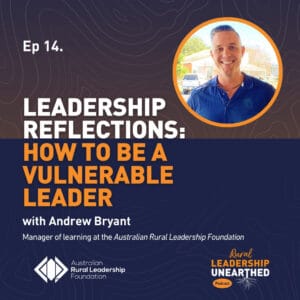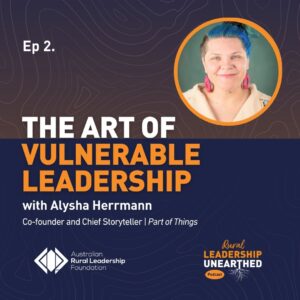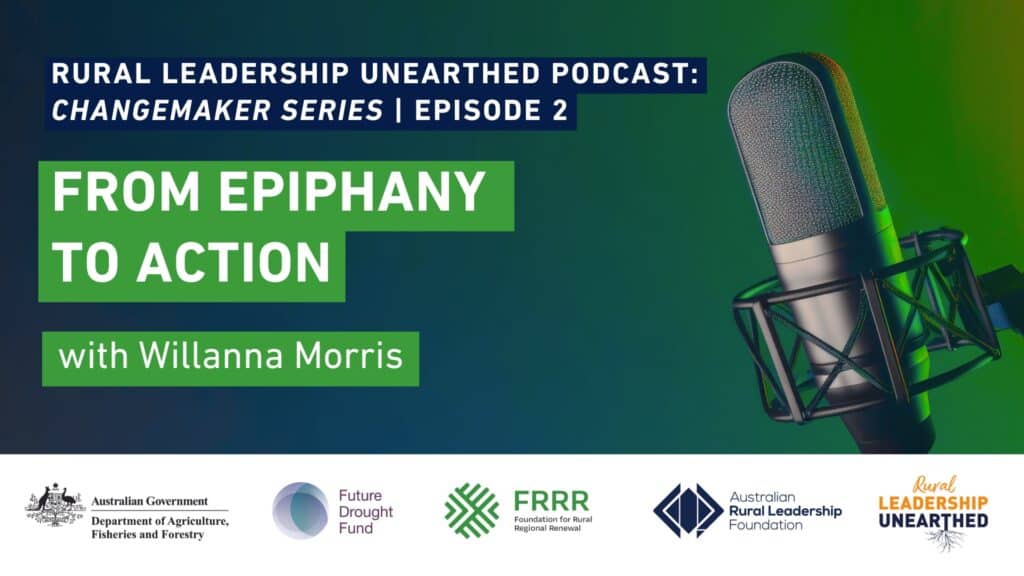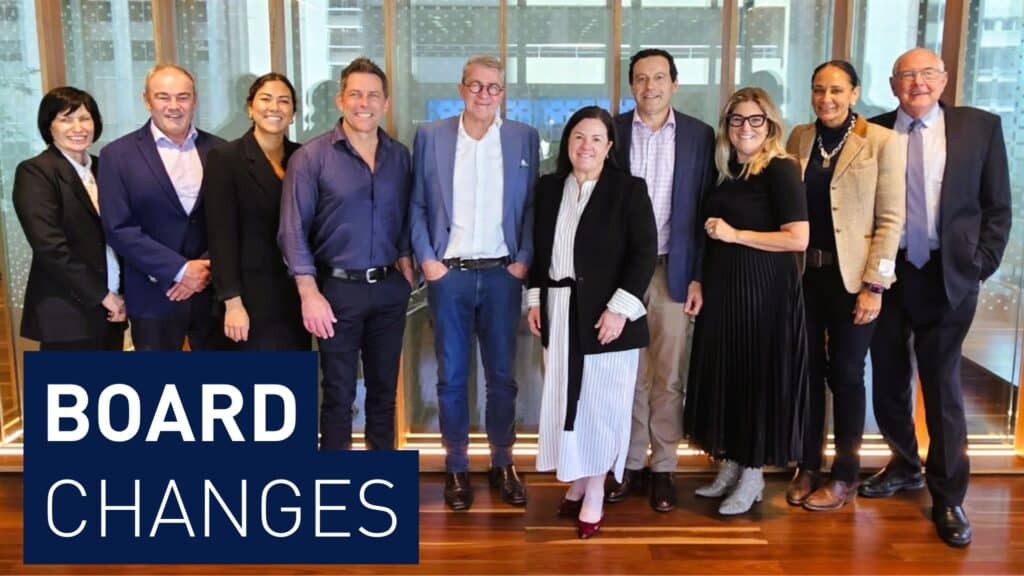How do we know where the line is between vulnerable leadership and oversharing? How do we cultivate the courage needed to be our authentic selves as leaders?
In the latest episode of the ARLF podcast, Rural Leadership Unearthed, we’re in conversation with ARLF manager of learning, Andrew Bryant. In this chat, theory meets practice, as we look at a real mini-case study and discuss what it takes to be a ‘vulnerable leader’. Andrew draws on our second ever episode; a conversation with regional arts leader Alysha Herrmann. Inspired by the way she frames the raw and difficult parts of her life to enhance her leadership, Andrew explores why it’s important to be vulnerable as leaders, and how to ‘do it well’.
Claire Delahunty: Andrew, do you mind giving our listeners a bit of background about you and about the work that you are doing with the Rural Leadership Foundation?
Andrew Bryant: I’m one of the learning managers at the Foundation. The majority of my work is assigned to the ‘helping regional communities prepare for drought’ initiative. We just call it the drought program. That’s where I’m doing a lot of my design and delivery and collaboration. We work across the 35 regions that are currently funded by the Future Drought Fund, which is exciting. And a large part of that work is the delivery of the Changemaker workshop. I came to the Foundation after I did 13 years in community services. I spent a long time as a youth and children’s counsellor, then a counsellor in the space of flood recovery in region that I came from. I went back to my home region. I’d grown up there till I was 19. I came from the little town of Gayndah in the North Burnett region, so it was largely citrus and beef production.
I went back there for a 12-month stint and ended up back there for 16 years. In that time, I did a couple of leadership programs, one of which was with the Australian Rural Leadership Program. I got very intrigued and curious about the work and about facilitation. In my counselling work, I facilitated groups. The therapeutic groups are a bit different, but certainly I liked being able to hold space for people. I stayed in touch with the Foundation and [they] ended up with a role for me. I have been with them now for about two and a half years doing design delivery work and loving getting to meet just amazing people from every corner of Australia. It’s a real privilege.
CD: Andrew, we’re here to do a bit of a new episode format. We’re going to get a bit of your insight and reflection on a snippet from one of our past podcast episodes. What did you end up choosing to discuss a bit further in terms of its implications for leadership?
AB: I honed in on ‘the art of vulnerable leadership’ with Alysha Herrmann, where she talked about what the ARLP program did for her in regards to confidence and walking into a room and, I’m paraphrasing, but essentially, the stuff that we go through rather than thinking it disqualifies me, or takes away from my leadership capacity and journey, it’s actually part of the moulding and shaping of who I am and what I bring as a leader. And that vulnerability and openness about not just the good stuff we get in life, but also the stuff that we, in the moment, we’d really rather not go through. But then seeing the gift that it has brought and how it’s developed us further down and that it is a gift to others in our leadership and being vulnerable and honest about that.
EXCERPT – Alysha Herrmann
“A lot of leadership is about the work we have to do on ourselves. And for me, one of those big ones, partly because of my background, has always been around confidence and self belief and backing myself and walking into a room and going, yeah, I am a high school dropout and a teen mom and I have experienced domestic and sexual violence. And those things have shaped me and shaped who I am and shaped how I see the world. And rather than that being but or in spite of it’s actually those things are part of what make me a valuable voice to have in the room. It’s actually what informs my leadership. And so really owning that story and how that story shapes the way that I show up.”
CD: What jumped out about that part of Alysha’s story to you?
AB: A few things there. I think maybe it’s more of a 21st century Western mindset, but we tend to avoid pain. We tend to avoid the negative. Sometimes the less desirable traits of our personality or the brokenness, I suppose, which we carry. Some might call it the shadow if they come from a Jungian perspective from the therapeutic world. But that authentic leadership involves the embracing of that and the encompassing of that in our practice. And Alysha also mentioned something about not just professional, but personal. And I think the reality is that for many of us sometimes, perhaps in the past, we like to imagine that the person we are in our personal life, we present something differently professionally. And look, we can all wear masks, but that’s all they are. And eventually a mask gets weathered and the cracks start to show and who we are will invariably come through. And whether we’re conscious of it or not, there really isn’t two different people when it comes not just to leadership, but even just people. Professionally, personally, we’re the same person. And the two spheres of our life will always leak into each other and influence the other. That flows into so many parts of leadership. It flows into the ethics we bring into leadership, in the honesty and transparency. We expect the people that we work with and the teams that we may work with to be honest and transparent. But if you can’t do that in who you are and how you show up, then it’s incongruent to expect that of others to do it as individuals and in a team.
It also helped me reflect too on my own leadership journey and realise the disparity sometimes between who I’ve been in my personal life and what I’ve wanted people to see professionally. And my hope is for all of us as we journey on that those two imaginary parts of us become more aligned until there’s no differentiation.
CD: What would you say are some of the keys to finding comfort in meshing those sides of us that we’re often taught to suppress one and celebrate the other?
AB: I think one of the lessons that I often tell myself is that the fear of what will happen if people see this or the fear of what could happen if I let it out is usually, not always, but usually much bigger than the reality. We anticipate that if someone sees this about me or what it will do and who will talk and how it will look and how I’ll feel. And then when we find the courage to be brave and do it, we realised it really wasn’t quite so bad as our imagination led us to believe. If we’re new in this space, sometimes people think if they just let everything gush out all at once in every forum that that’s being vulnerable. It’s like, no, that’s, if I’m being honest, that’s usually more irritating than it is being vulnerable. And we can overwhelm people.
So also having some wisdom with wanting to open up in this area of life and perhaps bring some light to some of the shadow parts of our leadership practice. Who are safe people and safe places that I can trial that with and see how it goes? I think there’s wisdom and safety for ourselves and for others. Because another part of it is in the practice of leadership, I believe we have a responsibility to care for our well-being and the well-being of others and sometimes stuff that we need to process, stuff that we need to be honest about, there’ll be people around us who don’t have the capacity to hold that for us. So being wise and having some of those trusted people, people who’ve maybe walked the path a few steps ahead of us and have been through it, yeah, that’s a good idea.
Realizing that sometimes some of the shame we feel around this stuff is a construct. our feelings often take a little while to catch up, but making the decision that I’m no longer going to see this as something that makes me less than, but as something that I’ve learned from and enhances who I am and what I bring to the practice of leadership. there’s never too much, you can never have too much humility in the space of leadership.
And if nothing else, going through and being vulnerable and facing some of the things that we’ve been through, the things that have happened to us, or who we are on the inside, it certainly brings humility. And if we’re bringing greater humility into the practice of leadership, then there is certainly no harm done.
CD: And does that need to happen intrinsically? Do we have to do it all by ourselves? What sort of things can support us to get to that place?
AB: Certainly we’re not incapable of doing that in the individual space, but all of us have, I guess, echo chambers where we just reinforce what we already believe. So for a lot of this work, we need other people. We need to be in community, whether that’s personally in the practice of leadership. I love that quote from Brene Brown that we are wired for connection. You can look at that biologically through neuroscience, the lens of philosophy or theology or whatever framework you’d like, but cross-culturally and around the world, we’re wired to be in connection with other people. And the practice of leadership is not excluded from that.
CD: What in general terms can it look like to support people through a process of finding the silver lining in some of those difficult, challenging, personal and maybe professional experience they’ve had in their lives?
AB: That’s one of the privileges of the work is watching people learn that about themselves and come to those realisations. For some people, it’s this moment of almost joy, when maybe a framework or a process sort of clicks for them and how that applies to them. And there’s this lessening of a self-imposed burden that they thought was how they’re supposed to show up and what was leadership and what wasn’t. Then having that paradigm sort of blown apart and realising that how they do things is just as legitimately able to be leadership as anything else.
For some people, there might be deeper work they need to go away and do where a leadership program is not a therapeutic community or a therapy group. So sometimes for some people, depending on where their leadership journey has gone and how they’re personal life links to that, they may need to go and do some more work on that, which is fantastic. For the most part, we don’t do change all of a sudden in great big bounds. It’s incremental steps over a longer period of time.
CD: What are the keys to vulnerable leadership? Obviously acknowledging that every personality and context is varied, but we often talk about vulnerability and authenticity. How do we get there and what might give us a sense that we’re on the right track?
AB: I think courage for the person. I remember someone I listened to once said that one of the most core human desires is to be fully known and to be fully accepted. He said, unfortunately, most people settle for one of those things, that they hide who they are in order to be accepted or they’re fully known … But I think courage to step into that space and be true to who you are is key.
I also think emotional intelligence is something that is needed to avoid that over-sharing that I talked about before. I love some of the definitions of emotional intelligence. There’s the self-awareness, the other awareness, the ability to regulate your own emotions and the ability to see and influence others. I think if we’re going to practice vulnerable leadership, that emotional intelligence is necessary so we don’t unnecessarily hurt others or burden others.
When you engage with people, it’s not always going to be perfect …Courage; emotional intelligence; being in community. I think they’re some of the main elements that I would consider from my experience around vulnerable leadership.
CD: How do we nurture our self belief and confidence against those knocks? Is it matter of a bit of armour? Is it a mantra? What are some healthy ways that we can retain that core sense that we’re okay, we’re doing well and we need to keep on going?
AB: I think that’s as unique as people are. I’m not a big fan of emotional and psychological armour. It kind of reminds me of when people talk about numbing through sort of addictive behaviours or through emotionally removing themselves, you can’t selectively do that. And I think it’s the same with armouring. If you’re gonna block out negative emotions, you’re gonna block out the positive ones as well. For me, it comes back to the community of people you have around you. I think having those valued people whose opinion matters, whose wisdom matters, whose love matters, having them is a protective factor. If someone says leadership can be lonely or leadership is lonely, you do it alone, it’s like, well, you’re doing it wrong. Okay, it might have worked for you up till now, but now you can do it better because you shouldn’t feel lonely. I get that there would be for those in some positional leadership that when a decision rests with you, you are alone in making that decision. But in other ways, you can get people around you to give you the support and the courage that you need.
As leaders, it’s like understanding not just everybody else’s, but your own worth as a person as separate to the outcomes, results, the good or bad decisions you make in leadership.
CD: Now I know you have said that you can’t learn this all from a book, but could you leave us with a favourite resource to help others check in with themselves or learn a bit more about vulnerable leadership?
AB: I’m going to leave with two very different things. Brene Brown’s very first TED Talk. It’s on YouTube. It’s been viewed millions of times, but I’ve listened to that four or five times. And when I need to remind myself of this, I go back to that again. And of course, everything that she’s done since is brilliant. But I think that first time that the world sat up and took notice of what she was saying on that stage.
And the character of Iron Man played by Robert Downey Jr. in the Marvel Cinematic Universe; that character arc from narcissistic playboy to the person who, you know, lays down his life like that. Yes, I know it’s a film. I know it’s the MCU, but there’s a reason why in cinemas around the world, people wept at that moment. That’s why we go to movies. We identify with something that’s going on. I think that’s a really cool story arc exploring what leadership looked like at the beginning for him to what it looked like at the end.
To catch the full interview, head to the Rural Leadership Unearthed podcast website.







